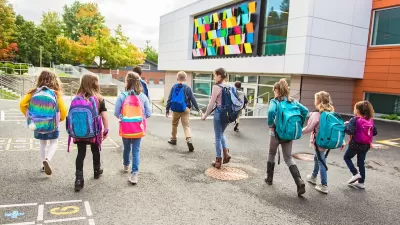Taking a wider view of communities could help keep schools open despite falling enrollment.

In this wide-ranging interview with Shelterforce's Editor-in-Chief Miriam Axel-Lute, Akira Drake Rodriguez, assistant professor at the University of Pennsylvania's Weitzman School of Design, discusses how school closures affect neighborhood stability and how communities are organizing to change school facilities planning processes.
Drawing from her research in Philadelphia, Rodriguez explores how school closures can lead to different outcomes in different neighborhoods — from gentrification to population decline. She examines alternatives to closing underutilized schools, such as co-location with community services, and describes how Philadelphia communities are working to make school facilities planning more participatory and equitable.
The interview highlights the deep connections between educational justice and housing justice, offering insights for planners and community developers about supporting local schools and preserving vital public infrastructure. Rodriguez argues for viewing schools as critical community anchors that provide more than just educational services.
Read the full interview at the source article in Shelterforce.
FULL STORY: A Better Way to Plan School Facilities

Montreal Mall to Become 6,000 Housing Units
Place Versailles will be transformed into a mixed-use complex over the next 25 years.

Planetizen Federal Action Tracker
A weekly monitor of how Trump’s orders and actions are impacting planners and planning in America.

DARTSpace Platform Streamlines Dallas TOD Application Process
The Dallas transit agency hopes a shorter permitting timeline will boost transit-oriented development around rail stations.

Interactive Map Reveals America's “Shade Deserts”
Launched by UCLA and American Forests to combat heat-related deaths, the tool maps the shade infrastructure for over 360 U.S. cities.

Bicycles and Books — In Sacramento, Libraries Now Offer Both
Adult library card holders can check out e-bikes and e-trikes for up to one week.

Colorado Landfills Emit as Much Pollution as 1M Cars
Landfills are the third-largest source of methane pollution in Colorado, after agriculture and fossil fuel extraction.
Urban Design for Planners 1: Software Tools
This six-course series explores essential urban design concepts using open source software and equips planners with the tools they need to participate fully in the urban design process.
Planning for Universal Design
Learn the tools for implementing Universal Design in planning regulations.
City of Mt Shasta
City of Camden Redevelopment Agency
City of Astoria
Transportation Research & Education Center (TREC) at Portland State University
US High Speed Rail Association
City of Camden Redevelopment Agency
Municipality of Princeton (NJ)





























